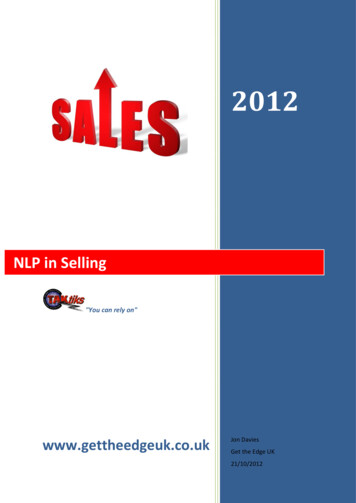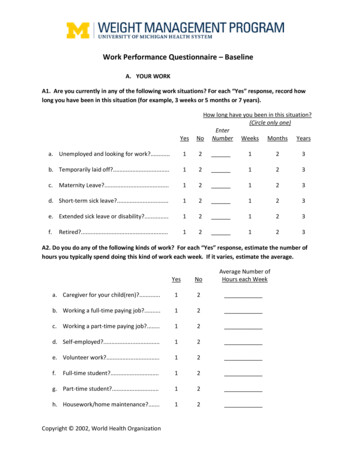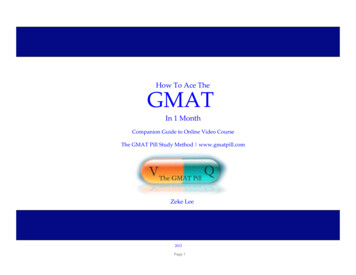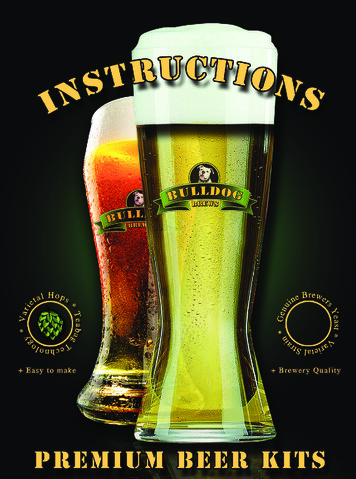
Transcription
2012NLP in Selling"You can rely on"www.gettheedgeuk.co.ukJon DaviesGet the Edge UK21/10/2012
The Ultimate Sales Tool KitNLP in SellingValues, positioning & sellingWhen you apply NLP in selling you will increase your customer satisfaction rating and yourrepeat business. The approach enables you to ensure that you match your products orservices to your customer's precise needs.and ensure that your customer is aware of how carefully you are attending to their needs!By doing this you are positioning yourself differently in the mind of your customer. You're nolonger just another 'rep' or even a salesperson. In their mind you become 'someone-to-beconsulted and a valuable resource rather than a nuisance-to-be-tolerated.Unrealistic? Not so.Customers respect salespeople who respect them.and the converse applies, too.Who do you prefer to buy from? The pushy salesperson who talks at you or the person whotakes the time to discover your needs and then helps you find the best match for these? Nota difficult choice, is it?It takes a little longer to sell this way. And a little more care. And a greater respect for yourcustomer. And quite a bit more skill.Yet it is not difficult to apply. The NLP in selling methods work equally well for retail sales asfor international salespeople selling high-ticket products and services. Because customersdon't like to be sold - they like to buy.And the key difference is in how you treat them.First they must buy you!Experienced sales people know that customers are unlikely to buy your product or service oridea if they don't like you. (Unless, of course, you are fortunate in being in a sellers' market.)First your customer must 'buy' you - only then will they consider 'buying' your product orservice or idea. NLP in selling is so powerful that, even where you are at a price or a technicalspecifications’ disadvantage, you can often get the order if your relationship with yourcustomer is right!Written By Jon Davies 2012
The Ultimate Sales Tool Kit'Relationship Selling'When we 'model' or extract the key ingredients of successful selling strategies in order toapply NLP in selling we find there are two chunks to the process:The task: to ensure that the customer recognises the value for them in your product orservice or idea - and buys. Most sales training courses and books on selling cater for thisside of selling.The relationship: this is either ignored or given minimal attention by most books, gurus, andtraining courses. Which partly explains how tough a field selling has become - salespeopleare inadequately equipped to deal with an increasingly sophisticated, better informed andmore demanding customer base.So sales people have begun looking for ways of becoming more skilful at being 'customerfriendly'! Instead of simply becoming more friendly with their customers!Yet so many sales people hate selling. They actually fear their customers. Because they see itas a numbers' game instead of a people game!When we model good sales people we find they actually like people. And people pick this upand, if the product and terms are right, they become customers!Great sales people build strong rapport with everyone they meet by using the followingstrategies.In NLP, Rapport is simply about increasing the number of similarities between yourself and aclient to allow them to relax and feel that you are like them.Obviously we are only interested in elements that you have control over, but there areplenty of other elements that help rapport. For instance people of the same sex, religion,race, or who support the same football team have a head start.There are numerous ways to gain rapport with someone, and the following elements can allbe matched: Breath rateVoice tone, rhythm and volumeSensory languageEmotional matching (stay in the same emotional state)Physical posture (i.e. if they've got crossed legs so have you. If you're sat opposite them youmatch on the opposite side - as if a mirror image)Physical movements (i.e. pick up your glass or touch your hair at the same time)Written By Jon Davies 2012
The Ultimate Sales Tool KitThe best way to improve your NLP rapport skills is to pick one element and practicematching in situations where you can relax and are not having to concentrate on anythingelse. This could be a situation such as in a queue or on a train.Simply try matching with a nearby stranger.The easiest way to notice if you have achieved your goal is if they suddenly become aware ofyou. As with all NLP skill, the more you practice the better you will become.Note on breath matching: If you're trying to match someone's breathing please do not stareat their chest! The best way to watch someone's breathing is to use your peripheral vision.It's not much of an excuse saying that you were practicing your NLP rapport skills!So sit or stand next to them and keep your eyes ahead, just move your awareness to theblurry edge of your vision.You will find that you can spot the movement much more easily.This is due to the fact that peripheral vision deals specifically with movement.Generally you will find that particular elements you match will have a stronger effect andthat some combinations are easier to use than others. Posture matching while matchingbreaking is a good combination to work on.It's important to spend time working on your NLP rapport skills. With practice you shouldfind that rapport becomes automatic.The key to sales is good communication. Here is how to use NLP to boost up yourcommunication skills, using the lessons from NLP to sell more effectively.Everyone has their 'preferred' languageListen to your customer. The words they use and sentence construction will give a goodindication of their preferred language.Some of us use visual words such as: see, looks; picture this, and other colourful andillustrative words. A visual may say "Can you see what I mean?"Written By Jon Davies 2012
The Ultimate Sales Tool KitThose who prefer auditory words, such as: listen or hear, sounds like, would rephrase thesentence as: "Can you hear what I'm saying?"Finally, the use of kinaesthetic phrasing, which focuses on how we feel about something,would result in something more like: "Do you get a feel for this?"Listen and look out for the words people use in conversationDoes your customer focus on visual words, say more auditory words or do you get thefeeling they may be kinaesthetic?Once you identify someone's style and can picture their representational system, respond tothem using their preferred language of words. It is unconsciously flattering to the receiverand they will also have a better understanding of the content. The benefit to any salesprocess is that rapport is built much faster a solid foundation for any sale.Match your sales strategy to your prospect's buying strategyDuring your sales pitch, be aware of showing pictures and samples to stimulate the visuals.Allow the kinaesthetics to handle the samples, they need to get a feel for something (pardonthe pun). Auditories are motivated by sound so be aware of the words you say and if yoursample can be switched on, do it so they can 'hear' the quality and pass comment on itsactions.A real winner is the NLP 'meta model', an absolute must for anyone wanting to cut to thechase in a sale when asked questions or faced with the anticipated 'objection'. The metamodel involves using the phrases 'what exactly do you mean' or 'how exactly'.By using the tools of the meta model you will be in a position to identify any missinginformation your customer may have deleted from the question or clarify any content that isdistorted or could be interpreted incorrectly. The meta model will help you to drill down forthe information you need to be able to respond accurately and with speed to questions,objections or levels of interest. Such questioning techniques will help locate the missingcontent you need.Written By Jon Davies 2012
The Ultimate Sales Tool KitAway from and towardsYour customer will either tell you what they do want - towards, or what they don't want away from. This is a great clue as to how they process information. If they are towards i.e.focused on what they want, explain your benefits in terms of what they will get. If they areaway from - geared to what they don't want. Tell them what they won't have to do, or whatthey won't have, or a mixture of the two: by owning your product, you won't have to worryabout X.Many great salespeople use these tools unconsciously. But by paying attention to the smallsignals from your customer, you can respond with a more targeted presentation.Somewhat like property being about location, location, location, when using NLP, sales is allabout state, state, state. For most people, it's simply about getting them into the correctbuying state and then shoving the product in their face."Can you remember the last time you just had to have something?""Is there something you brought recently, just on impulse? You saw it and you had to haveit?""What's something you just wouldn't hesitate to buy straight away?"All these questions can be used to get someone moving in the right direction, and once youhave them in state, you can anchor the state and access it when talking about your product.There are many different NLP anchoring techniques. Hopefully this article will get youstarted and then you can develop various anchoring techniques of your own. NLP Anchoringis incredibly easy to understand and with a little practice many NLP anchoring techniquescan become almost automatic.The idea is simple, get a client or customer into a specific mental state (the stronger andmore distinct the better), and create an association to it so that the state can be reaccessed (activated) at will.In this article we will be dealing with the more subtle NLP anchoring techniques that youcan use within a sales environment, rather than the kind of anchoring often used with NLPWritten By Jon Davies 2012
The Ultimate Sales Tool Kitclients where it is possible to build a really strong state and keep accessing it simplybecause the client is happy to go along with your instructions.So, for a covert form of anchoring, there are four skills involved:Access a powerful stateRecognise when to set the anchorAnchor the state as specifically as possibleFire the anchor when requiredTaking these one by one:Access a powerful stateFirstly, it is important to decide what state is being anchored.If you're trying to sell then you probably want your customer to be in a wanton buyingstate. The simplest way to access a state is to get the customer to remember a time whenthey were in that state:"Can you remember a time when you saw something, and you just had to have it?""Have you ever seen something, and just brought it immediately on impulse?"These kind of questions force the customer to remember a time that matches the state,and to do that they must access the state. This is key to the success of your nlp anchoringtechniques,Other powerful states you may want to access include frustration (about your competitors),clarity, and stubbornness (if they've come to see you with a friend who is trying to put themoff).When to set the NLP anchorThe key to success with most NLP anchoring techniques is to watch the customer as theyaccess their memories.The best time to anchor the state is exactly as they access the state linked to the memory.So watch their eyes and keep an eye out for any subtle body movements.If they suddenly drop their shoulders or become otherwise relaxed, or in some casesbecome more alert and excited, then this is the time to set the anchor.Anchor the state as specifically as possibleMost people anchor with a touch. The best places for touch anchors are those are parts ofthe body that are easy to re-access, seem completely natural, and can be touched withoutoffending or upsetting the customer.The elbow or the shoulder are good for this. Remember that areas with more nerve endingsneed to be anchored more accurately, and avoid areas that are likely to be touched often.As well as touch, which can be difficult to use in a sales environment, there are many otherways to create anchors.Written By Jon Davies 2012
The Ultimate Sales Tool KitThese include:a particular word (especially in a particular tone)a particular facial gesture (such as a raised eyebrow)a particular gesture such as pointing or scratching your noseIt is also useful to use multiple NLP anchors together. Using touch and a particular wordtogether is more powerful (and specific) that just using the touch or the word.If you touch their shoulder, raise your eyebrow, and say 'great' all at the same time youhave anchored visually, auditory, and kinesthetically, which is very powerful.Fire the anchor when requiredIf you're selling something and you've set an anchor for a very powerful buying state thenthere are specific times you may wish to fire the anchor.The first time you show the customer the product you want them to buy, or the momentyou bring the contract out to sign are the kind of moments when you should fire theanchor.Like most NLP skills, the more you practice with different NLP anchoring techniques thebetter you will become. It's best to have a plan the first few times you use thesetechniques. Also it is useful to use the same anchors with all your customers so you don'thave to remember each one individually. Anchoring in this way will become almost secondnature after a few practices.Dealing with objectionsWhatever you're selling, there will always be objections.Sometimes, they will be valid - it's simply the wrong product for the customer, butsometimes not.As a salesperson, the best approach is to be prepared for objections, and already know whatyour response is likely to be should the objection occur.In fact, a key NLP sales technique is to bring up the likely objections yourself as this will stopthe customer in their tracks.For instance:"Now some people would say that this security system is too expensive, but then what priceWritten By Jon Davies 2012
The Ultimate Sales Tool Kitdo you put on the safety of yourself and your family.Imagine coming home and finding your house had been broken into, and you don't knowwhere your children are, and even after everything has been fixed up, you can't walk in thefront door without remember how awful it felt?"Decision StrategiesSome people make buying decisions really difficult.They may want to see several products before making a decision, they may just not like youor your company, or they may want to sleep on it.So how do you get around the problem of people who need time to pass before they canmake a decision? Is there an NLP sales technique to deal with this issue? Yes, there is.Usually, these people have already made the decision, they just need to wait before actuallyparting with the cash.No one really knows why, or what they think might happen in the required time frame, butthese people will usually not budge.So how do you speed up the time process? What NLP sales techniques should you use?NLP In Selling Intro - I hope you find this introduction to NLP useful,type NLP in Google to learn more about this great tool, change yourresults, your behaviour and your lives for the better.Written By Jon Davies 2012
The Ultimate Sales Tool KitTwo Great BooksTo help improve your income and grow your salesEach filled withdynamic ideas,techniques, tacticsand tips, to grow,your results to newlevels in 2012To get your copy visitwww.gettheedgeuk.co.ukor emailjon@getthedgeuk.co.ukWritten By Jon Davies 2012
The Ultimate Sales Tool Kit Written By Jon Davies 2012 NLP in Selling Values, positioning & selling When you apply NLP in selling you will increase your customer satisfaction rating and your repeat business. The approach enables you to ensure that you match your











